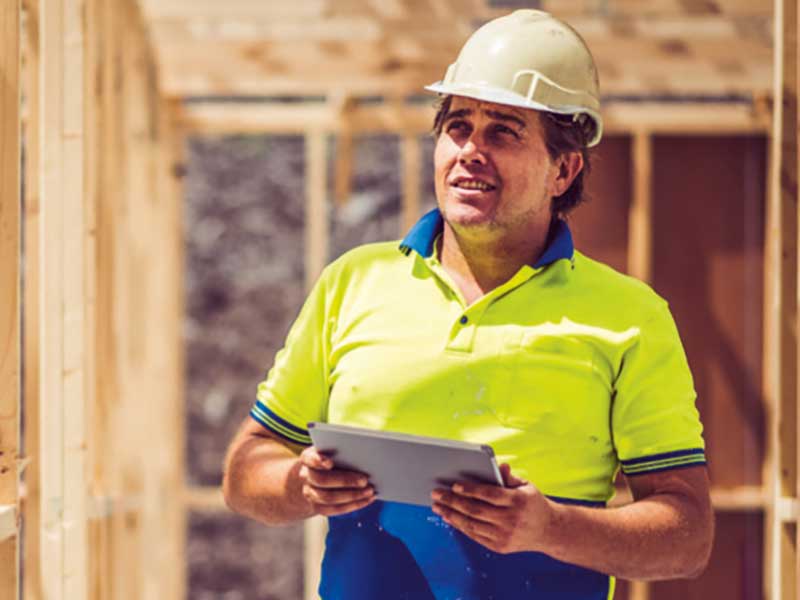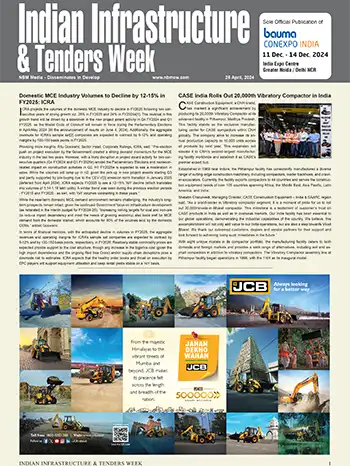Critical Considerations for Effectively Digitalizing the Engineering & Construction Industry

The Engineering & Construction (E&C) industry has typically lagged behind its peers in adopting cutting-edge technology. However, E&C companies have now begun to witness the humungous benefits that digitalization can reap. From increased productivity to enhanced safety at job sites and improved resource utilization – there’s no denying that technology can drive significant positive business outcomes and more and more E&C companies are looking to embark on a digitalization journey.
However, there is still a lot of ambiguity on how to go about such large-scale transformations, with no straightforward answers to questions such as – What is the correct starting point for a digital transformation? Is a big bang or incremental approach right for this change? How will the inherent dynamism of the construction industry affect digitalization?
While there cannot be a ‘one-size-fits-all’ approach towards digitalization in any industry, this paper delves into key considerations that impact the success of digitalization efforts, based on our vast experience of working on several digital transformation programs in the E&C space.
People
Effective Organization Structure Embedded with Digital Champions
A key consideration while planning a digital transformation is ensuring the right organization structure to facilitate it. The responsibility and accountability for ensuring that the transformation is a success cannot lie with a standalone siloed digital organization that works independently but instead needs to be shared with the business organization. It is also imperative that individuals at different levels of the organization champion the transformation. In a recent digital program for a leading construction major, we followed a dual-accountability model, with a Central Digital Organization leading the technical aspects of the digital implementation and Digital Officers within the business organization being responsible for business-related aspects, including functional alignment and user adoption.Involvement of Business Teams during Solution Conceptualization and Design
It is essential that key stakeholders have faith in the potential of transformation programs underway and the conviction that digital technologies can not only support their business needs, but also drive improvements. By being involved in the conceptualization of the digital solution, these business stakeholders can shape how the solution evolves and promote its usage within their organization. This helps bridge the business-IT alignment gap. Not only is involving business teams from the onset crucial, but also getting the business to sponsor quick Proofs of Concepts (PoCs) and pilot digital implementations is beneficial for getting their buy-in into the digital transformation.Right Skilling and Capability Building to promote Digital Adoption
Solutions aimed at digitalizing the construction industry range from IoT sensors on key equipment to RFID sensors for tracking movement of workers across the construction site to digitized material tracking solutions such as digital weighbridges. The intended users of these solutions are typically teams working on project sites — construction workers, site engineers, store managers, and plant and machinery managers. While digitalizing the construction industry, it is important that these users receive the necessary training to understand the purpose of these solutions to be able to use them correctly. Also, depending on the solution complexity, the on-ground team may need to be equipped with the necessary skills for basic troubleshooting of the solution. For example, in case of remote construction sites, having the on-ground Plant & Machinery (P&M) teams perform basic troubleshooting of equipment sensors (ensuring they are properly connected to a power source, etc.) can be extremely beneficial and save both time and money on technical support.Process
Plan for Phasing out Manual / Old Processes with Automated / Digitally-Enabled Ones
An anticipated and taken-for-granted outcome of digitalization is that it will simplify everyday tasks of users in areas where it is deployed, and free up time and effort to be spent on more value-adding activities. However, if not fully thought through and planned well, digitalization could end up creating additional effort, resulting in user frustration and poor adoption.Consider, for example, a Digital Progress Reporting tool for tracking the output of work done at site daily, wherein site engineers must key in the quantum of work done on their section and an automated report is created on the overall site progress for use during internal daily project reviews. However, the site engineer also continues to have to enter data in the previously used spreadsheets, as progress reporting to the client is still based on these spreadsheets. This will result in duplication of efforts and eventually adoption of the new system will suffer. In this case, it would be most fitting to ensure that the client reporting process can also be modified based on the new solution.
Structural Changes Driven by Digitalization to Unlock Full Value Potential
Very often, the view towards the advantages that digitalization can bring about is rather short-sighted. In the E&C industry, technology is still largely seen as an enabler, rather than a driver of business change. However, to do full justice to the potential of digitization, it is highly essential to take a step back and evaluate whether digital solutions can drive business changes that can positively impact the organization’s KPIs.In a recent study, batching plants used for producing concrete were digitally connected to capture and monitor their utilization and production output on an hourly basis. Plants with insufficient capacity, in comparison to their plans, would typically purchase Ready Mix Concrete (RMC) from the market at a higher cost. Visibility into production and plans of neighboring plants on an hourly basis resulted in the potential to establish processes for sharing of concrete across plants within a certain proximity to each other. Ancillary processes were set up to support the transportation logistics and financial accounting for sharing. This structural change of sharing concrete between sites that was a result of digitalization resulted in increased plant utilization by 10% and a 6% reduction in the purchase of costlier RMC.
Effective Governance Mechanisms
A very critical aspect of any transformation program is governance and digitalization transformations are no exception. Large transformation programs need to have processes set up for regular progress reviews, change communication and broadcasting, and value measurement and monitoring. Governance is more of a challenge when the transformation spans multiple business units and geographies, and the pace of transformation and digital maturity across units are not uniform. In such cases, governance mechanisms may be customized as per the needs of each business unit. It is also important to ensure that operational governance continues even after the transformation is complete, with a shift of focus to driving adoption of the new solutions, and ensuring sustainability of associated business changes and capturing benefits.Tools / Technology
Right-Fitting and Right-Timing the Technology Change
With companies waxing eloquent about their success from digitization, it is tempting to leap onto the digital bandwagon. However, without the necessary groundwork, this could be a recipe for disaster. For a disruptive technology to be successful, it not only requires an organizational ecosystem that is digitally mature enough to provide a backbone to the transformation, but also an entire technical ecosystem to support it with the right set of services, standards, guidelines and regulations — both internally and externally.Consider, for example, a road construction company that has recently installed sensors on its equipment that capture various machine health and operational parameters. The company plans to use Artificial Intelligence to predict the breakdown and failure of these equipment. In the absence of sufficient historical equipment parameters and breakdown data to train the AI algorithms, it is unlikely that such a model built on a few months of data will yield accurate results. Another example could be the implementation of a Connected Machinery solution within a geography, where the basic infrastructure and network connectivity to support it is lacking. While these are not showstoppers to digitalization, companies should be cognizant of the prerequisites to rolling out disruptive technologies and should factor in plans for solving such roadblocks into their transformation journeys.
Integration of Digital Solutions within Overall Technology Landscape
Introduction of new digital technologies into any organization’s technology landscape must be considered within the purview of the broader technology landscape encompassing both traditional and disruptive technologies. Very often, Digital and IT organizations function independently of each other, and digital strategy and planning is done independently of IT strategy, resulting in systems not talking to each other and duplicate systems running in parallel, performing the same or similar functions, ultimately leading to end-user frustration. In the E&C industry, where digital tools and solutions are very diverse, there is potential to derive immense synergies by effectively integrating systems.In a recent consulting engagement, our client had a robust process in place for weighing material flowing into the construction sites using digitized weighbridges. However, the material receipt note that was generated in the ERP system was based on a manual feed of material quantity, which was subject to manipulation. In an attempt to reconcile data between these two sources, it was discovered that this seemingly minor integration miss had resulted in major material losses for the company, reinforcing the criticality of tightly coupling systems together.
Quality Assurance of Digital Technologies
Digital quality assurance is imperative to ensure an optimal end-user experience. In today’s world, the focus is often on getting the solution in production at the earliest and crunching the time-to-market, using agile methodologies and DevOps. While it’s great to give users a chance to get their hands on the technology in a live production environment as soon as possible, quality processes should not be compromised in the process.With very new technologies, the digital implementation teams particularly need to ensure that major technical glitches are ironed out before pushing for solution adoption. If not, it is very likely that the early rollout will backfire and result in an overall disgruntlement with the solution due to defective outputs. The inherent nature of the E&C industry – job sites in remote locations without sufficient network connectivity and sometimes power sources, interference from materials such as concrete and steel to the working of technologies like RFID, rough usage of both material and machinery that are to be ‘connected’ — makes it more challenging to ensure quality data outputs from Connected Solutions in this industry. This, combined with the fact that project teams at job sites are often looking for an excuse to continue their existing way of working and not digitalize, make quality assurance a critical factor to the success of construction digitalization.
While this paper has provided an introduction into the important aspects to be taken into consideration while undergoing a digital transformation, the subsequent papers in this compilation provide further insights into how digital technologies can transform construction planning, tendering, labor, P&M, and material management, so as to improve KPIs such as P&M utilization, labor productivity, planned vs. actual project completion and material wastage, and ultimately result in cost savings for the organization.

About the Author
Samara leads the Strategy & Value Realization practice within LTIMindtree’s Consulting organization. She works with CXOs and senior leaders to develop & drive digital transformation strategies and has helped clients derive tangible business outcomes by effectively leveraging digital technologies. She has deep domain expertise in the areas of EPC and manufacturing.LTIMindtree is a global technology consulting and digital solutions company that enables enterprises across industries to reimagine business models, accelerate innovation, and maximize growth by harnessing digital technologies. As a digital transformation partner to more than 700 clients, LTIMindtree brings extensive domain and technology expertise to help drive superior competitive differentiation, customer experiences, and business outcomes in a converging world. Powered by 84,000+ talented and entrepreneurial professionals across more than 30 countries, LTIMindtree — a Larsen & Toubro Group company — combines the industry-acclaimed strengths of erstwhile Larsen and Toubro Infotech and Mindtree in solving the most complex business challenges and delivering transformation at scale. For more information, please visit https://www.ltimindtree.com
NBM&CW October 2023


















